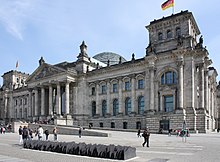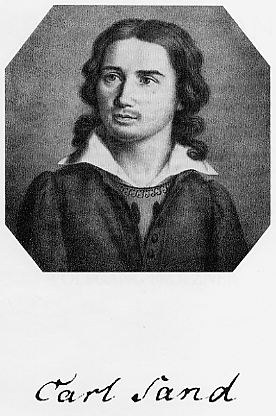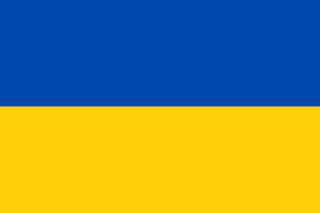| Name | Birth | Death | Place of death | Political party |
|---|
| Adler, Julius Julius Adler | 1894 | 1945 | KZ Bergen-Belsen | KPD |
| Adlhoch, Hans Hans Adlhoch | 1884 | 1945 | Munich, before death march | BVP |
| Alexander, Eduard Eduard Alexander | 1881 | 1945 | Transport to KZ Bergen-Belsen | KPD |
| Aßmann, Julius Julius Aßmann | 1868 | 1939 | Bodino, Poland, assassinated | DVP |
| Augustat, Elise Elise Augustat | 1889 | 1940 | KZ Ravensbrück | KPD |
| Bästlein, Bernhard Bernhard Bästlein | 1894 | 1944 | Zuchthaus Brandenburg | KPD |
| Artur Becker | 1905 | 1938 | Burgos, Spain, murdered | KPD |
| Bias, Anton Anton Bias | 1876 | 1945 | KZ Dachau | SPD |
| Biedermann, Adolf Adolf Biedermann | 1881 | 1933 | Found dead near Recklinghausen | SPD |
| Blenkle, Conrad Conrad Blenkle | 1901 | 1943 | Zuchthaus Berlin-Plötzensee | KPD |
| Bockius, Fritz Fritz Bockius | 1882 | 1945 | KZ Mauthausen | Zentrum |
| Bohm-Schuch, Clara Clara Bohm-Schuch | 1879 | 1936 | Barnimstrasse women's prison | SPD |
| Bolz, Eugen Eugen Bolz | 1881 | 1945 | Zuchthaus Berlin-Plötzensee | Zentrum |
| Breitscheid, Rudolf Rudolf Breitscheid | 1874 | 1944 | KZ Buchenwald | SPD |
| Breunig, Lorenz Lorenz Breunig | 1882 | 1945 | KZ Sachsenhausen | SPD |
| Broßwitz, Conrad Conrad Broßwitz | 1881 | 1945 | KZ Dachau | SPD |
| Eggerstedt, Otto Otto Eggerstedt | 1886 | 1933 | KZ Esterwegen | SPD |
| Eppstein, Eugen Eugen Eppstein | 1878 | 1943 | KZ Lublin | KPD |
| Fleischer, Helene Helene Fleischer | 1899 | 1941 | Stadtroda | KPD |
| Funk, Albert Albert Funk | 1894 | 1933 | Police headquarters, Recklinghausen | KPD |
| Geiselhart, Otto Otto Geiselhart | 1890 | 1933 | District court prison, Günzburg | SPD |
| Gerig, Otto Otto Gerig | 1885 | 1944 | KZ Buchenwald | Zentrum |
| Gerlach, Paul Paul Gerlach | 1888 | 1944 | KZ Sachsenhausen | SPD |
| Grube (politician), Ernst Ernst Grube (politician) | 1890 | 1945 | KZ Bergen-Belsen | KPD |
| Haindl, Franz Franz Haindl | 1879 | 1941 | Landesanstalt Sonnenstein-Pirna | DBP |
| Hamm, Eduard Eduard Hamm | 1879 | 1944 | Gefängnis Berlin Lehrterstraße | DDP |
| Heilmann, Ernst Ernst Heilmann | 1881 | 1940 | KZ Buchenwald | SPD |
| Hennig, Rudolf Rudolf Hennig | 1895 | 1944 | KZ Sachsenhausen | KPD |
| Herbert, Franz Franz Herbert | 1885 | 1945 | KZ Mauthausen | BVP |
| Herbst, Eugen Eugen Herbst | 1903 | 1934 | KZ Dachau | KPD |
| Heuck, Christian Christian Heuck | 1892 | 1934 | Prison Neumünster | KPD |
| Heym, Guido Guido Heym | 1882 | 1945 | Shot by SS in Weimar | KPD |
| Hilferding, Rudolf Rudolf Hilferding | 1877 | 1941 | Gefängnis Paris La-Sante | SPD |
| Hoch, Gustav Gustav Hoch | 1862 | 1942 | KZ Theresienstadt | SPD |
| Horn, Lambert Lambert Horn | 1899 | 1939 | KZ Sachsenhausen | KPD |
| Husemann, Friedrich Friedrich Husemann | 1873 | 1935 | KZ Esterwegen | SPD |
| Janka, Albert Albert Janka | 1907 | 1933 | KZ Reichenbach | KPD |
| Jasper, Heinrich Heinrich Jasper | 1875 | 1945 | KZ Bergen-Belsen | SPD |
| Jendrosch, Friedrich Friedrich Jendrosch | 1890 | 1944 | KZ Sachsenhausen | KPD |
| Jürgensen, Reinhold Reinhold Jürgensen | 1898 | 1934 | KZ Fuhlsbüttel | KPD |
| Kaiser, Eugen Eugen Kaiser | 1879 | 1945 | KZ Dachau | SPD |
| Kayser, Albert Albert Kayser | 1898 | 1944 | KZ Buchenwald | KPD |
| Kessel, Franziska Franziska Kessel | 1906 | 1934 | Zuchthaus Mainz | KPD |
| Krzikalla, Anton Anton Krzikalla | 1887 | 1944 | KZ Sachsenhausen | KPD |
| Künstler, Franz Franz Künstler | 1888 | 1942 | Berlin, Spätfolgen des KZ Lichtenburg | SPD |
| Lademann, Max Max Lademann | 1896 | 1941 | KZ Sachsenhausen | KPD |
| Leber, Julius Julius Leber | 1891 | 1945 | Zuchthaus Berlin-Plötzensee | SPD |
| Lejeune-Jung, Paul Paul Lejeune-Jung | 1882 | 1944 | Zuchthaus Berlin-Plötzensee | CHR.N.A |
| Lipinski, Richard Richard Lipinski | 1867 | 1936 | Bennewitz | SPD |
| Mache, Karl Karl Mache | 1882 | 1934 | KZ Kislau | SPD [2] |
| Maddalena, Max Max Maddalena | 1895 | 1943 | Prison Brandenburg-Görden | KPD |
| Marum, Ludwig Ludwig Marum | 1882 | 1934 | KZ Kislau | SPD |
| Meier, Stefan Stefan Meier | 1889 | 1944 | KZ Mauthausen | SPD |
| Merges, August August Merges | 1870 | 1945 | Braunschweig Wolfenbüttel prison | SPD [3] [4] |
| Metz, Franz Franz Metz | 1878 | 1945 | KZ Dachau | SPD |
| Moses, Julius Julius Moses | 1868 | 1942 | KZ Theresienstadt | SPD |
| Nagel, Arthur Arthur Nagel | 1890 | 1945 | KZ Bergen-Belsen | KPD |
| Neubauer, Theodor Theodor Neubauer | 1890 | 1945 | Brandenburg-Görden prison | KPD |
| Petrich, Franz Franz Petrich | 1889 | 1945 | Sonnenburg prison | SPD |
| Portune, Andreas Andreas Portune | 1875 | 1945 | Roslau | SPD |
| Puchta, Friedrich Friedrich Puchta | 1883 | 1945 | KZ Dachau | SPD |
| Putz, Ernst Ernst Putz | 1896 | 1933 | Berlin-Moabit prison | KPD |
| Rädel, Siegfried Siegfried Rädel | 1893 | 1943 | Zuchthaus Berlin-Plötzensee | KPD |
| Redlich, Paul Paul Redlich | 1893 | 1944 | KZ Sonnenburg | KPD |
| Reek, Walter Walter Reek | 1878 | 1933 | Danzig prison | SPD |
| Reinke, Ernst Ernst Reinke | 1891 | 1943 | KZ Flossenbürg | KPD |
| Richter, Max Max Richter | 1881 | 1945 | Neustädter Bucht, transportation to KZ Neuengamme | SPD |
| Roeingh, Theodor Theodor Roeingh | 1882 | 1945 | KZ Sachsenhausen | Zentrum |
| Rosemann, Julius Julius Rosemann | 1878 | 1933 | Hamm police jail | SPD |
| Sattler, Karl Karl Sattler | 1896 | 1945 | KZ Bergen-Belsen | KPD |
| Schehr, John John Schehr | 1896 | 1934 | Schäferberg/Kilometerberg: shot "escaping" | KPD |
| Schnabrich, Michael Michael Schnabrich | 1880 | 1939 | KZ Sachsenhausen | SPD |
| Ernst Schneller | 1890 | 1944 | KZ Sachsenhausen | KPD |
| Schneppenhorst, Ernst Ernst Schneppenhorst | 1881 | 1945 | Gefängnis Berlin Lehrterstraße | SPD |
| Scholem, Werner Werner Scholem | 1895 | 1940 | KZ Buchenwald | KPD |
| Schumann, Georg Georg Schumann | 1886 | 1945 | Detention in Dresden | KPD |
| Walter Schütz | 1897 | 1933 | Murdered in Königsberg by the SA | KPD |
| Sinzheimer, Hugo Hugo Sinzheimer | 1875 | 1945 | Overveen Gemeente Bloemendaal (Niederlande) | SPD |
| Skamira, Willi Willi Skamira | 1897 | 1945 | Brandenburg-Görden prison | KPD |
| Soldmann, Fritz Fritz Soldmann | 1878 | 1945 | KZ Buchenwald | SPD |
| Stamm, Robert Robert Stamm | 1900 | 1937 | Berlin-Plötzensee prison | KPD |
| Stelling, Johannes Johannes Stelling | 1877 | 1933 | District court prison, Berlin-Köpenick | SPD |
| Stenzer, Franz Franz Stenzer | 1900 | 1933 | KZ Dachau | KPD |
| Stöcker, Walter Walter Stöcker | 1891 | 1939 | KZ Buchenwald | USPD, KPD |
| Streiter, Georg Georg Streiter | 1884 | 1945 | KZ Ravensbrück | DVP |
| Streufert, August August Streufert | 1887 | 1944 | KZ Neuengamme | SPD |
| Tempel, Hermann Hermann Tempel | 1889 | 1944 | Oldenburg, Haftfolgen Wölfenbüttel prison | SPD |
| Tesch, Johanna Johanna Tesch | 1875 | 1945 | KZ Ravensbrück | SPD |
| Thälmann, Ernst Ernst Thälmann | 1886 | 1944 | KZ Buchenwald | KPD |
| Thesen, Mathias Mathias Thesen | 1891 | 1944 | KZ Sachsenhausen | KPD |
| Thielen, Nikolaus Nikolaus Thielen | 1901 | 1944 | KZ Mauthausen | KPD |
| Voigt, Fritz Fritz Voigt | 1882 | 1945 | Berlin-Plötzensee prison | SPD |
| Voigt, Paul Paul Voigt | 1876 | 1944 | Murdered in Berlin | SPD |
| Wegmann, Paul Paul Wegmann | 1889 | 1945 | KZ Bergen-Belsen | USPD |
| Wendt, Georg Georg Wendt | 1889 | 1948 | Berlin, before Brandenburg prison | SPD |
| Zinke, Lotte Lotte Zinke | 1891 | 1944 | KZ Ravensbrück | KPD |
|













